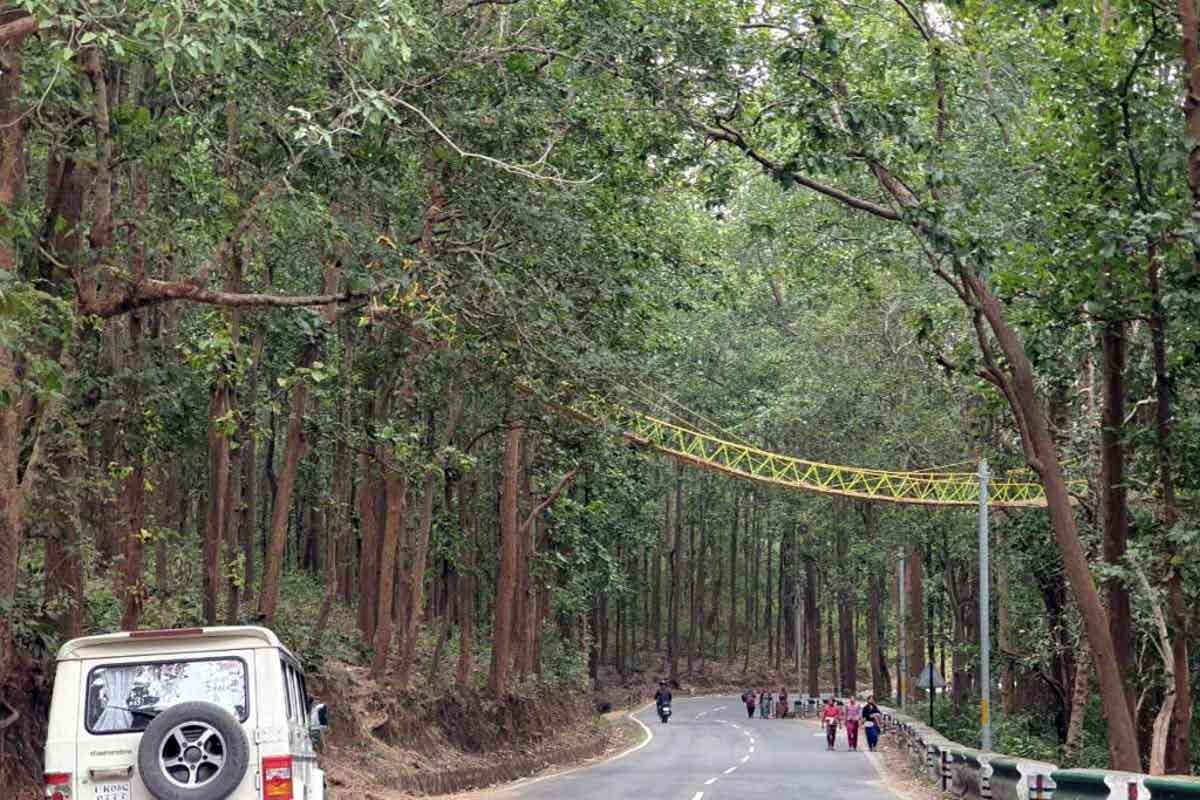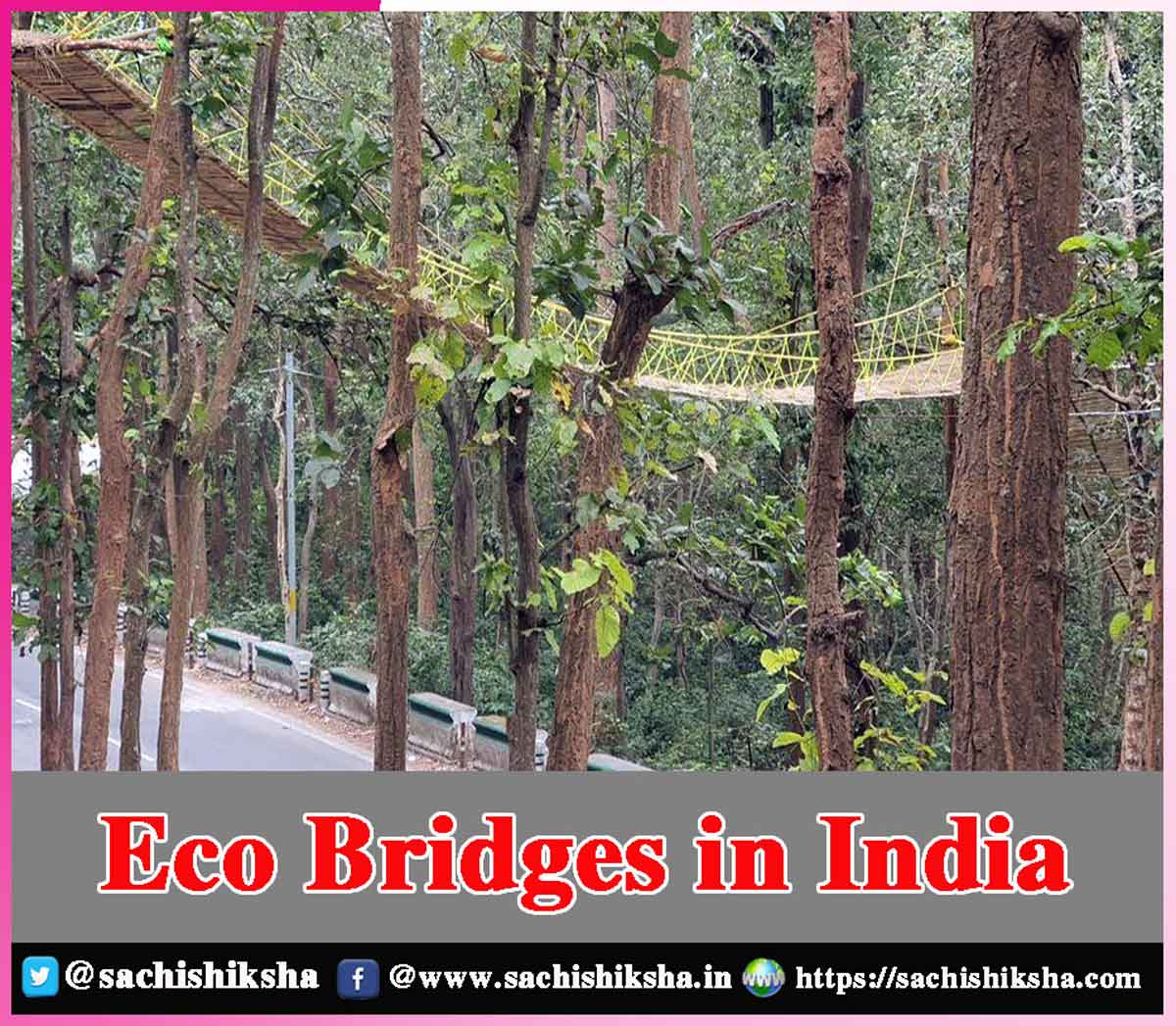Eco Bridges in India
Introduction Eco bridges, also known as wildlife crossings are structures built over or under roads, railways, or waterways to facilitate the safe passage of wildlife. These bridges help to mitigate the negative impacts of human infrastructure on animal habitats and migration patterns.
Table of Contents
Forms of Eco Bridges
Eco bridges come in various forms, including overpasses, underpasses, and tunnels. These bridges are designed to mimic the natural environment to encourage animals to use them. They can be landscaped with vegetation, rocks, and other features to make them more appealing and functional for wildlife.
Benefits of Eco Bridges

Role of Eco Bridges in Conservation Efforts
Eco-bridges, also known as wildlife crossings or eco ducts, are structures built over or under highways and roads to reconnect fragmented habitats for wildlife, allowing them to safely cross from one side to another. In India, these eco-bridges play a significant role in conservation efforts due to several reasons:
Biodiversity Conservation:
India is home to diverse flora and fauna, including several endangered species. Eco-bridges help in conserving biodiversity by mitigating habitat fragmentation caused by roads and highways.
Mitigation of Human-Wildlife Conflict:
Roads often lead to increased instances of human-wildlife conflict as animals attempt to cross them, resulting in accidents. Eco-bridges provide a safe passage for wildlife, reducing the likelihood of such conflicts.
Maintaining Genetic Diversity:
Fragmented habitats can lead to genetic isolation among wildlife populations, reducing genetic diversity. Eco-bridges facilitate the movement of individuals between populations, thus helping maintain genetic diversity.
Promotion of Ecotourism:
Many eco-bridges are designed to be aesthetically pleasing and informative, attracting tourists interested in wildlife and conservation. This can contribute to local economies through ecotourism.
Long-term Infrastructure Investment:
While eco-bridges require initial investment, they serve as long-term infrastructure investments by reducing costs associated with wildlife-related accidents, damage to property, and healthcare expenses.
Climate Change Resilience:
By preserving and connecting habitats, eco-bridges contribute to building resilience in ecosystems, helping wildlife adapt to climate change by providing migration routes and access to resources.
Legislative and Policy Support:
India has various Wildlife Protection Acts and policies that mandate the conservation of endangered species and their habitats. Eco-bridges align with these regulations and support the government’s conservation efforts.
Public Awareness and Education:
Eco-bridges serve as platforms for raising awareness about wildlife conservation among the public through signage, educational displays, and visitor centers associated with these structures.
Need of Eco Bridges in India
Eco brides in India represent a growing trend towards sustainability and environmental consciousness. Here are some reasons why eco brides are gaining prominence:
Environmental Awareness:
With increasing awareness about climate change and environmental degradation, many couples are seeking ways to minimize their ecological footprint, even on their wedding day.
Desire for Meaningful Celebrations:
Eco brides often prioritize meaningful experiences over extravagant displays of wealth. They seek to align their values with their wedding choices, opting for eco-friendly options that reflect their commitment to sustainability.
Support for Local Communities:
Eco brides often choose locally sourced materials and vendors for their weddings, supporting local artisans and businesses. The result not only saves carbon dioxide emissions from transportation. It additionally benefits the economy of the region.
Setting a Positive Example:
By choosing eco-friendly wedding options, brides and grooms can inspire their guests to adopt more sustainable practices in their own lives. This ripple effect can contribute to larger societal changes towards sustainability.
Connection with Nature:
Many eco brides feel a deep connection with nature and want to celebrate their love in a way that honors the environment. This might involve outdoor ceremonies, natural decor, or even choosing venues with sustainable practices.
The rise of eco bridges in India reflects a broader global shift towards sustainability and conscious consumerism. As environmental concerns continue to gain prominence, eco-friendly weddings are likely to become even more popular in the years to come.
Salim Ali Bird Conservation Bridge
The first eco bridge of India, known as the “Salim Ali Bird Conservation Bridge,” is a pioneering project located in the state of Kerala. Named after the renowned Indian ornithologist Salim Ali, the bridge spans the National Highway 212 near the town of Nilambur in the Malappuram district. Constructed with the aim of mitigating wildlife-vehicle collisions and preserving the biodiversity of the region, the Eco Bridge is a testament to India’s commitment to sustainable infrastructure development. It serves as a safe passage for various species of birds, small mammals, and reptiles, allowing them to cross the busy highway safely.
To monitor the effectiveness of the eco bridge, wildlife cameras and sensor-based monitoring systems have been installed to track animal movements. The success of the Salim Ali Bird Conservation Bridge sets a precedent for future eco-friendly infrastructure projects across the country, reinforcing the idea that development and conservation can go hand in hand.
The Uttrakhand Eco Bridge
Another Eco Bridge in Uttrakhand, also known as the “Dobra-Chanthi Bridge,” is a groundbreaking project located in the picturesque state of Uttrakhand in northern India. Situated near the village of Dobra in the Tehri Garhwal district, this innovative bridge serves as a vital link for both human and animal communities while promoting ecological conservation.
The Uttrakhand Eco Bridge is designed to facilitate the movement of wildlife, particularly in the fragile mountain ecosystem. It provides a safe passage for various species of animals, including leopards, bears, deer, and smaller mammals, allowing them to traverse the landscape without the risk of human interference or vehicle collisions. The bridge’s construction emphasizes environmental sustainability, with minimal disruption to the surrounding habitat. In addition to its ecological significance, the Uttrakhand Eco Bridge serves as a crucial transportation link for local communities. It connects remote villages, facilitating access to essential services such as healthcare, education, and markets.
Other Eco Bridges in India
Bandipur National Park Eco Bridges (Karnataka):
Bandipur National Park in Karnataka has implemented several eco bridges and underpasses along the National Highway 67 to facilitate the movement of wildlife, particularly elephants, across the busy highway.
Mumbai Eastern Freeway Wildlife Underpasses (Maharashtra):
Along the Mumbai Eastern Freeway in Maharashtra, several wildlife underpasses have been constructed to allow animals to safely cross under the busy highway.
These are just a few examples of eco bridges and wildlife crossings in India, with efforts focused on mitigating human-wildlife conflicts, reducing habitat fragmentation, and promoting ecological connectivity. The emergence of eco bridges in India marks a significant step towards the intersection of infrastructure development and environmental conservation. These innovative structures serve as crucial links between fragmented habitats, promoting wildlife movement and genetic diversity while simultaneously addressing the challenges of human-wildlife conflict and habitat fragmentation.
Importance of Eco Bridges
Prioritize Needs of Humans & Wildlife:
Eco bridges prioritize the needs of humans and wildlife, fostering coexistence and sustainable development. They represent a proactive approach to mitigating the negative impacts of infrastructure projects on biodiversity, offering solutions that harmonize ecological integrity with human progress.
Embody Ecologically Sensitive Development Practices:
As India continues to face rapid urbanization and expanding transportation networks, the importance of eco bridges cannot be overlooked. They embody a paradigm shift towards more holistic and ecologically sensitive development practices, demonstrating that progress and conservation are not mutually exclusive but rather complementary goals.
Conclusion
Looking ahead, the proliferation of eco bridges across India holds promise for the protection of wildlife corridors, the enhancement of biodiversity, and the preservation of natural ecosystems. By embracing these innovative solutions, India can pave the way towards a more sustainable future where infrastructure development and environmental stewardship go hand in hand.













































